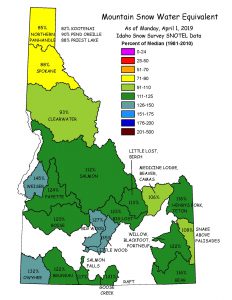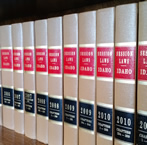Upcoming Meetings
2025 May Water Supply Meeting
When: Tuesday, May 20, | 9:00am – 11:30pm (MST)
Where: United States Bureau of Reclamation, 230 N. Collins Rd., Boise, ID, 83702
Virtual Option: here
Overview
As soon as information concerning the upcoming year’s water supply becomes available, IDWR begins analyzing the data to determine if there is potential for a water supply problem. If it becomes apparent that a problem could occur, IDWR alerts the Governor’s Office and organizes a water supply committee to coordinate all drought-related activities in Idaho. This reduces confusion and sets up a means to provide the public with the best possible advice on steps which can be taken to minimize the drought’s impact.
Depending upon the stage and magnitude of the water supply problem, the Water Supply Committee may organize a variety of subcommittees (described below) to help meet its goals. The committee chairman can request that various organizations assign personnel to the subcommittees, and then appoints a chairman for each subcommittee. Each subcommittee chairman is responsible for the organization, membership, and function of the subcommittee and reports to the Water Supply Committee on activities, goals, and progress.
Historical Background
Idaho usually has adequate surface water supplies, but those water supplies are cyclic. Some years, there is too much and other years not enough. Idaho has experienced a number of water shortages. The earliest well-documented shortages occurred in the 1920s and 1930s during the Dust Bowl era. These historic records are still used today as a benchmark in evaluating potential problems.
Idaho has not been without problems since then. During the early 1960s, several areas in the state experienced water shortages. In 1977, the worst single year on record, a severe water shortage occurred throughout Idaho and the West. In 1987, the water supply ranged from 10 to 50 percent below normal over many areas of the state. The impacts were kept to a minimum because of a good reservoir carry-over supply from 1986 and judicious use of water.
In 1988, even though the overall supply was better (at around 70 percent of normal), the impact was greater because of poor carry-over reservoir storage and dry soil conditions. Conditions in 1991 and 1992 mirrored conditions in 1987 and 1988. Overall, conditions between 1987 and 1993 in the southwestern part of Idaho have displaced the Dust Bowl period of the 1930s as the most severe period of drought on record.
As a result of the 1977 drought, state, federal, and local agencies directed considerable effort toward drought planning and assistance. Valuable information was collected, many water supply problems were addressed, and drought response procedures were developed. An important item not completed in 1977, was the production of a “Drought Plan.” In 1990, a plan was designed to fill that need. The Idaho Water Supply Committee was developed as one action element of that plan
Water Supply Meeting Presentations
Role
This committee:
- Compiles all data to provide the most comprehensive information available concerning the drought.
- Coordinates with the various agencies to avoid conflict or duplication and expedites the administrative process.
- Provides responsible and timely public information.
- Encourages water and energy conservation.
Organization
The committee is composed of key state, federal, and private agencies that have interests, constituents, and responsibilities which might be impacted by the water supply situation. The standing water supply committee is composed of, but is not limited to, the following agencies:
- Idaho Department of Water Resources – Chair
- Idaho Bureau of Disaster Services
- Idaho Department of Health and Welfare, Division of Environmental Quality
- Idaho Department of Agriculture
- University of Idaho Cooperative Extension Service
- Idaho Department of Fish and Game
- Idaho Department of Commerce
- U.S. Bureau of Reclamation
- National Weather Service
- Natural Resource Conservation Service
- U.S. Army Corps of Engineers
- U.S. Geological Survey
- U.S. Forest Service
- Consolidated Farm Service Agency
- Idaho Power Company
Goals
The Water Supply Committee meets and reviews the best information available relative to the water supply. The committee implements the response process with the following goals.
- Supply adequate domestic (culinary) water for public health, safety, and welfare as a first priority.
- Minimize adverse drought effects on the state’s economy, environment, and social well-being.
- Maintain municipal supplies to meet community needs.
- Efficiently use available water supplies to provide for agricultural needs. Farm activities must be planned with a knowledge of anticipated water supplies.
- Maintain productive Idaho industries to provide a stable local economy.
- Modify water and land management practices, where possible, to minimize environmental impacts.
- Protect fish and wildlife to the extent practical by water and land management.
- Protect recreation interests to the extent practical by water and land management.
- Minimize forest and range hazard due to fire and erosion to the extent practical by land management.
- Institute electrical energy conservation practices to assure an adequate supply for all purposes.
- Carefully manage reservoir storage and releases to maximize total water-related benefits.
- Protect navigation capability, where essential to the economic well-being of a community, to the extent possible through streamflow management.
If a severe water shortage seems possible, the committee may develop a formal contingency plan. During the 1987-1994 period, some steps were partially implemented because even though the shortage was the worst in 50 years, it was not necessary for state government to implement a demand reduction program. The committee did encourage that some steps be the responsibility of local city or county governments. The committee provided technical and administrative support and helped local governments develop programs suited to their individual problems. A drought plan was developed and the Water Data Subcommittee implemented a monitoring program.
Water Supply Subcommittees
- Compile and analyze water supply and energy data and forecast water supply availability. Provide technical assistance to the other subcommittees.
- Membership includes IDWR, National Weather Service (NWS), Bureau of Reclamation (BOR), Natural Resource Conservation Service (NRCS), U.S. Army Corps of Engineers (COE), and U.S. Geological Survey (USGS).
- Evaluate and monitor energy supplies; coordinate with other subcommittees.
- Coordinate with the state member of the Northwest Power Planning Council.
- Membership includes Idaho Northwest Power Planning Council, Idaho Public Utilities Commission, Bonneville Power Administration, Idaho Power Co., IDWR, the Association of Commerce and Industry, COE, and BOR.
- Organize information about the drought and conservation measures in a form understandable to the public.
- Coordinate public information distributed from individual organizations in order to prevent public confusion.
- Membership should include information officers from public organizations.
- nvestigate and monitor areas of critical need to determine where habitat might be threatened and where water and land management practices could improve fish, wildlife, and recreational values, including water quality problems.
- Determine potential of impact to recreation and tourism. Coordinate with Public Information Subcommittee to provide positive recreation information minimizing impact to the tourism industry.
- Monitor land management, fire suppression, and issues relative to impacts and actions on grazing and operational changes dealing with fire hazard and suppression.
- Membership includes Idaho Department of Commerce, Idaho Department of Fish and Game, U.S. Fish & Wildlife Service, Idaho Department of Lands, Idaho Division of Environmental Quality, Idaho Department of Parks and Recreation, U.S. Forest Service, and U.S. Bureau of Land Management.
- Investigate and monitor water shortage problems with municipal systems and industrial users; provide technical assistance. Coordinate energy issues with the Energy Subcommittee.
- Membership includes IDWR, Idaho Department of Health Welfare (HW) (also health districts), Association of Commerce and Industry, and the Association of Idaho Cities.
- Evaluate and monitor needs of individuals and organizations financially affected by the drought.
- Assist in obtaining financing for supplementary water sources.
- Membership includes Farmers Home Administration, Conservation Farm Service Agency, Idaho Bankers Association, Idaho Department of Commerce, Legislative Revenue and Taxation Committee, and the Budget Bureau.










